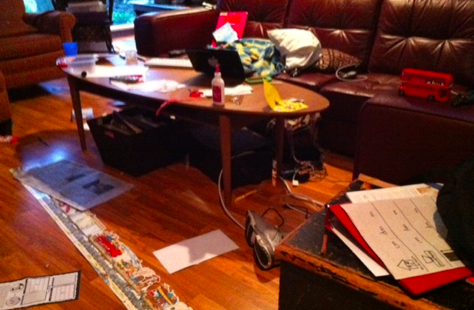“How do you do it?”
This is one of my favourite questions, and I get it pretty regularly. It usually comes up when I refer to my kids — as in, how do you manage to parent two kids and have a career? Or it comes up when I make a reference to my occasional moonlighting with Social Signal — as in, how do you manage to work with clients when you’ve got a full-time job? Or it comes up when I talk about all my various social media activities — as in, how do you write five blog posts a week and still get any sleep? But most often it comes up in its composite form: how do you do it all?
I love this question because it’s a major ego trip. It’s a chance for me to just sink into the gratifying sense that yes, I have achieved my goal of appearing superhuman, of overachieving, of fitting 28 hours into a 24 hour day. Whenever somebody asks me how I do it?, I get to make some kind of gently self-deprecating denial while gloating over the recognition that yes, I’ve managed to stump another one.
But how do you do it? is one of those unhealthy byproducts of online life. As I discussed in my recent post about coping with the #sxsw backchannel,
if there is one thing the Internet (and especially Twitter and Facebook) are good at, it’s letting us know about all the things we aren’t doing. Conversely, it’s pretty terrible at letting us know about all the things other people aren’t doing. So when you read the 140-character tweet that says “Just had great chat with @worldfamousguru at #ExclusiveConference that will make me stronger, faster & more attractive to same/opposite sex,” what you’re not seeing are characters 141-180 that would have read: “….while my children cry themselves to sleep and my partner berates me for once again leaving town, work, home and family responsibilities.”
The gratification we get from amazing people with all the things we are doing is part of what feeds this dynamic. When we are read, or followed, or retweeted, or mentioned, it tells us that whatever we are doing at this moment has in some way been counted. We get a little dose of attention for whatever we’ve just shared, and like rats, we share the next thing in pursuit of another hit. We share and we share until our whirlwind of activity is enough to prompt the question, how do you do it?
But for all the satisfactions of how do you do it?, it comes at a cost. We fill up our social media streams with all the news of our activities, instead of seeking out and celebrating our undocumentable moments: the moments that are too exciting to stop and tweet, or too elusive to sum up in a blog post.
I’m not suggesting we stop sharing, but rather, that we wean ourselves from the how do you do it? The next time a blog post or tweet tempts you to ask that question, try filling in the blanks: not with the assumption that each reported accomplishment but a drop in someone’s ocean of achievement, but with the possibility that it’s the only thing they have to share.
As for those of us who are addicted to hearing the question, we have even more work in store. We need to lose our dependence on projecting superhuman activity, and acknowledge the merely human reality that we are all constantly making choices about what to do and what to neglect, about what to share and what to hide.
Sharing more online about what we’re not doing offline is one way to kick the how do you do it? addiction. In which spirit, here’s what our living room currently looks, while I sit here writing this blog post:

The horror, the horror!
But the other way to let go of how do you do it? is to actually answer the question. In which spirit, I’m going to spend this week sharing the secrets of how I do it, at least online. I hope they can help you do it…without getting you addicted to the question, too.

Someday I am going to incorporate into a blog post the fact that our lives have sort of become the social media equivalent of “if a tree falls in the forest and no one is around to hear it …..” as in “if I had a reunion with my childhood best friend who I had not seen in 30 years, we had a marvelous time, ate interesting local food, and walked away with hearts lifted and spirits soaring BUT had failed to document the moment with a smart phone, camera, or other method of sharing it via social media, did it happen or “count” at all?”
I wholeheartedly concur that the “real time life” happening out of the scope of social media (goodnight stories with kids; family fights; routine meals; all of the things that make up our lives but don’t get shared) is a bigger part of “all” than most of the statuses, tweets, and social media comments combined.
Fantastic post. As a working mom I love to see your living room and know that I’m not the only one who lets a few things slide on the domestic front in order to enjoy the time I do have with my family and friends. Part of how we get it all done is that we each have to choose what “all” means in our own lives. I can’t wait to read your upcoming posts.